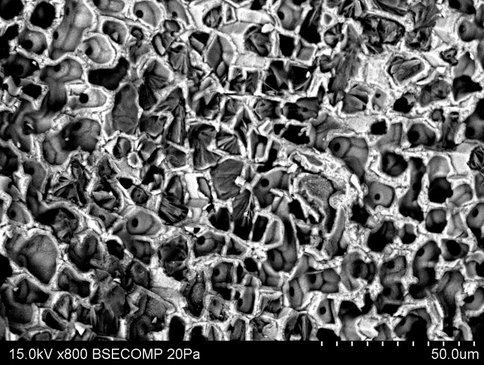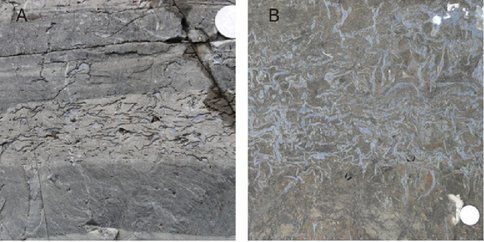2013 Annual Science Report
 University of Wisconsin
Reporting | SEP 2012 – AUG 2013
University of Wisconsin
Reporting | SEP 2012 – AUG 2013
Project 1C: Compositional and Structural Variations in Dolomite and Ca-Bearing Magnesite From Modern and Ancient Carbonate Sediments
Project Summary
Low-temperature Ca-Mg carbonates that have a wide range of chemical variation (from high-Mg calcite to Ca-bearing magnesite) may be used as a biosignature. Certain polysaccharides can inhibit aragonite precipitation and promote Ca-Mg-carbonate crystallization. Experiments indicate that ancient low-temperature, non-stoichiometry dolomite with the observed nano-precipitates of Ca-rich phases may be used as a biosignature.
Project Progress
We have investigated protodolomite, disordered dolomite and Ca-bearing magnesite from the Great Barrier Reef (Australia). The studied Ca-Mg-carbonates are produced by organisms of coralline alga dominated by polysaccharides. Although majority of the carbonates are high-Mg calcite, there are also Ca-rich protodolomite, Mg-rich protodolomite, and Ca-bearing magnesite micro- and nano-crystals around the cell walls of coralline alga. Dissolved polysaccharides around cell walls and in “chamber” like areas surrounded by cell walls result in the precipitation of the protodolomite and even Ca-bearing magnesite from modern seawater at low-temperature (Fig. 1). Low-temperatures Ca-Mg carbonates with wide range of chemical variation (from high-Mg calcite to Ca-bearing magnesite) may be used as a biosignature. Certain polysaccharides can inhibit aragonite precipitation and promote Ca-Mg-carbonate (even magnesite) crystallization.
Polysaccharides can catalyze Ca-rich dolomite Mg-rich dolomite precipitation. Carbonate sediments that are rich in polysaccharides may be preferentially dolomitized. Precambrian carbonate rocks with “molar tooth” texture from Helena Formation of Belt Supergroup (Fig. 2) were selected for studying their microstructures and compositional variations. The host carbonate is dominated by dolomite micro-crystals. It was proposed that precursor for the molar tooth dolomite is gelatin-like carbonate mud that is rich in microbial extracellular polymeric substances substances (EPS). Polysaccharides are the dominant components in the EPS. Z-contrast images of the Ca-rich dolomite show two types of Ca-rich precipitates in the host dolomite. The nano-precipitates are Mg-calcite and an ordered nano-phase with an ordering sequence of Ca-Ca-Mg along c-axis. The new ordered nano-phase has hexagonal structure with composition between those of calcite and stoichiometric dolomite. The results indicate that EPS-rich carbonate muds were preferentially dolomitized into Ca-rich protodolomite. Late stage aging during diagenesis and low-grad metamorphism resulted in the observed nano-precipitates of Mg-calcite and the new hexagonal phase. Low-temperature non-stoichiometry dolomite with the observed nano-precipitates may be used as a biosignature.
Publications
-
Nash, M. C., Opdyke, B. N., Wu, Z., Xu, H., & Trafford, J. M. (2014). Simple X-Ray Diffraction Techniques To Identify MG Calcite, Dolomite, and Magnesite In Tropical Coralline Algae and Assess Peak Asymmetry. Journal of Sedimentary Research, 83(12), 1084–1098. doi:10.2110/jsr.2013.67
-
Shen, Z., Konishi, H., Brown, P. E., & Xu, H. (2013). STEM investigation of exsolution lamellae and “c” reflections in Ca-rich dolomite from the Platteville Formation, western Wisconsin. American Mineralogist, 98(4), 760–766. doi:10.2138/am.2013.4184
-
Shen, Z., Konishi, H., Szlufarska, I., Brown, P. E., & Xu, H. (2014). Z-contrast imaging and ab initio study on “d” superstructure in sedimentary dolomite. American Mineralogist, 99(7), 1413–1419. doi:10.2138/am.2014.4647
-
PROJECT INVESTIGATORS:
-
PROJECT MEMBERS:
Huifang Xu
Project Investigator
Hiromi Konishi
Collaborator
Minglu Liu
Collaborator
Zhizhang Shen
Collaborator
Izabela Szlufarska
Collaborator
-
RELATED OBJECTIVES:
Objective 7.1
Biosignatures to be sought in Solar System materials
Objective 7.2
Biosignatures to be sought in nearby planetary systems

